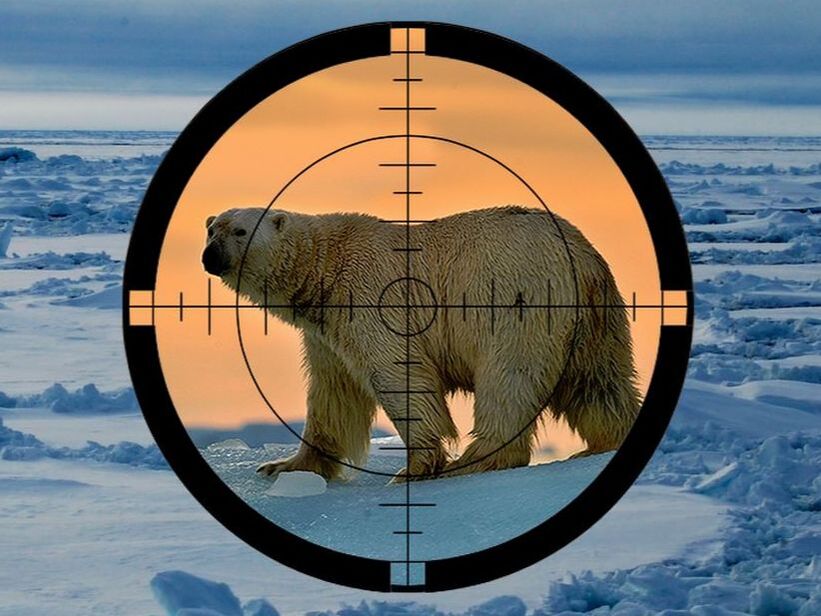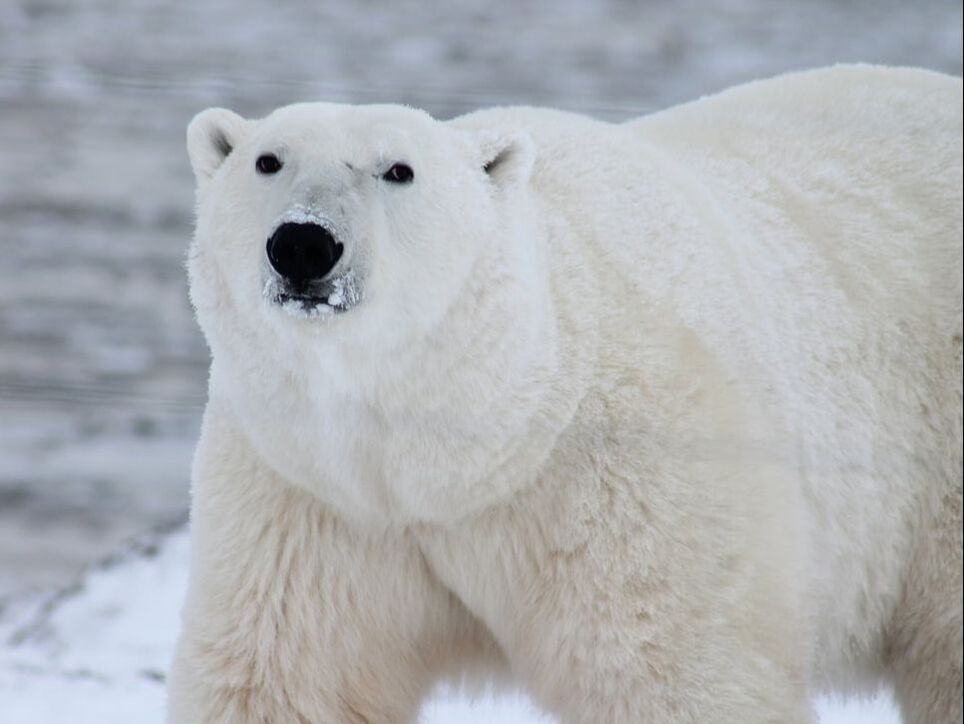Some Canadian Inuit communities believe that there are too many polar bears and
that climate change is not affecting populations. Scientists strongly disagree on both
counts. Incredibly, however, Inuit are now considering measures to reduce polar bear
populations. Their plans include killing a greater number of females and even cubs.
The skins of the majority of polar bear skins from these so called 'traditional hunts'
end up in the international fur trade. So what's going on?
that climate change is not affecting populations. Scientists strongly disagree on both
counts. Incredibly, however, Inuit are now considering measures to reduce polar bear
populations. Their plans include killing a greater number of females and even cubs.
The skins of the majority of polar bear skins from these so called 'traditional hunts'
end up in the international fur trade. So what's going on?
Polar bears on the edge of survival
Polar bears and seals, their main source of food, depend on sea ice to survive. The seals need ice to raise their pups, while polar bears depend on it to catch seals. Climate change causes the sea ice to melt earlier and freeze later in the year, progressively narrowing the window during which this is possible and forces polar bears to spend increasingly longer periods on land without food. This effect is most pronounced in the southern part of the arctic.
The polar bear population of Western Hudson Bay, at the southern end of the species' current distribution, is the best studied polar bear population on earth. Here, polar bears fast for at least four months until the sea refreezes and they can hunt again. Pregnant females have to forego food for eight months, as they give birth and nurse their cubs until they are finally old enough to leave the maternity den behind and return to the sea ice to hunt. Fasting for two thirds of a year pushes polar bear mothers to the very brink of their energetic limit. Scientists found that poor physical condition, survival and birth rates are all linked to the earlier break-up of sea ice. In fact, sightings of mothers with cubs have become a rarity.
The polar bear population of Western Hudson Bay, at the southern end of the species' current distribution, is the best studied polar bear population on earth. Here, polar bears fast for at least four months until the sea refreezes and they can hunt again. Pregnant females have to forego food for eight months, as they give birth and nurse their cubs until they are finally old enough to leave the maternity den behind and return to the sea ice to hunt. Fasting for two thirds of a year pushes polar bear mothers to the very brink of their energetic limit. Scientists found that poor physical condition, survival and birth rates are all linked to the earlier break-up of sea ice. In fact, sightings of mothers with cubs have become a rarity.
As malnourished bears are forced to spend increasingly long periods on land due to lack of sea ice, more have ventured into settlements in search of food. This has led the Inuit government of Nunavut, which retains the ultimate authority over polar bear management in the area, to claim that there are in fact too many polar bears. It went further by suggesting that polar bear numbers have now increased to a point where they are jeopardizing both public safety and the environment. To address this perceived problem, they are considering to actively reduce polar bear numbers in certain subpopulations by permitting native hunters to kill a higher number of females and even cubs.
“It’s for the safety of the public that we want to reduce our polar bear population"
Stanley Adjuk, chair of the Kivalliq Wildlife Board
|
Scientists have long since considered such proposals ill advised. Prof. Sterling, Research Scientist Emeritus for Environment and Climate Change Canada and Adjunct Professor of the Department of Biological Sciences at the University of Alberta has studied polar bears throughout the Canadian Arctic for close to 40 years. He explains that the presence of polar bears in around some coastal settlements “was interpreted as evidence that the populations were increasing, which led to increased allowable harvest levels, despite scientific evidence that the populations were declining in two areas and a lack of current population data for a third population”. “Polar bears have home ranges that often exceed 200,000 km2”, he explains, “and roam far beyond the purvey of hunters based on or near the coast; therefore, it is simply not possible to develop a population perspective from anecdotal observations of polar bears.” |
|
Danish and Norwegian polar bear experts Christian Sonne, Aaage Alstrup, Bjorn Jenssen and Rune Dietz also urged the Nunavut Inuit to rabandon these proposals. Reducing the number of Nunavut's female polar bears would impair the pupulation's reproductive capacity but do little to address the human-bear conflicts. They warn that at best, it "will take decades to correct" this course of action because of the species' slow reproduction. At worst, these changes would be irreversible as additional man-made stressors for a population that is predicted to collapse or maybe even become extinct by 2100 as a result of climate change.
The polar bears of Western Hudson Bay are struggling to survive in a world that has become progressively unsupportive to their needs. Yet, hunting to supply the international skin trade and trophies continues with quotas that are not supported by science. |
A disastrous new Manangement Plan
Under Canadian law, Inuit knowledge or Qaujimajatuqangit is considered equally important as science in setting native hunting quotas for polar bears and managing their populations. In September 2019, the government of Nunavut approved its new polar bear management plan that had been in the making since 2015. The new plan includes the option to actively reduce polar bear numbers and approves a substantial increase in the number of female bears that can be killed by Inuit hunters. It also claims that climate change does not harm populations. and even allows for polar bear cubs to be hunted. Cubs that are killed will be counted against quotas as half an adult male. The plan allegedly aims to protect public saftey and the environment. However, most hunts supply the international fur and trophy trade.
Prior to the new plan's appoval, the Head of the Canadian Wildlife Service's Polar Bear Management Unit, Samuel Iverson warned that the Government of Nunavut has not provided hard data to back up an increase in female kills. If it does, “we would like to see that information,” he said. |
"We know what we are doing and western science and modelling has become too dominant." |
Canada's polar bear management has
|
 Ole J Liodden is at home in the arctic
Ole J Liodden is at home in the arctic
“It has become politically incorrect to question the Inuit or their polar bear management, especially when it comes to terms such as ‘sustainable harvest’ and ‘subsistence harvest," says conservationist, author, acclaimed wildlife photographer and PNP polar bear conservation advisor Ole J Liodden.
“It used to be an important part of Inuit tradition for hunters to treat the polar bears with respect - before and after death. Killing simply for fun is not compatible with that tradition and many Inuit hunters and leaders were, and still are, opposed to trophy hunting for that reason.”










